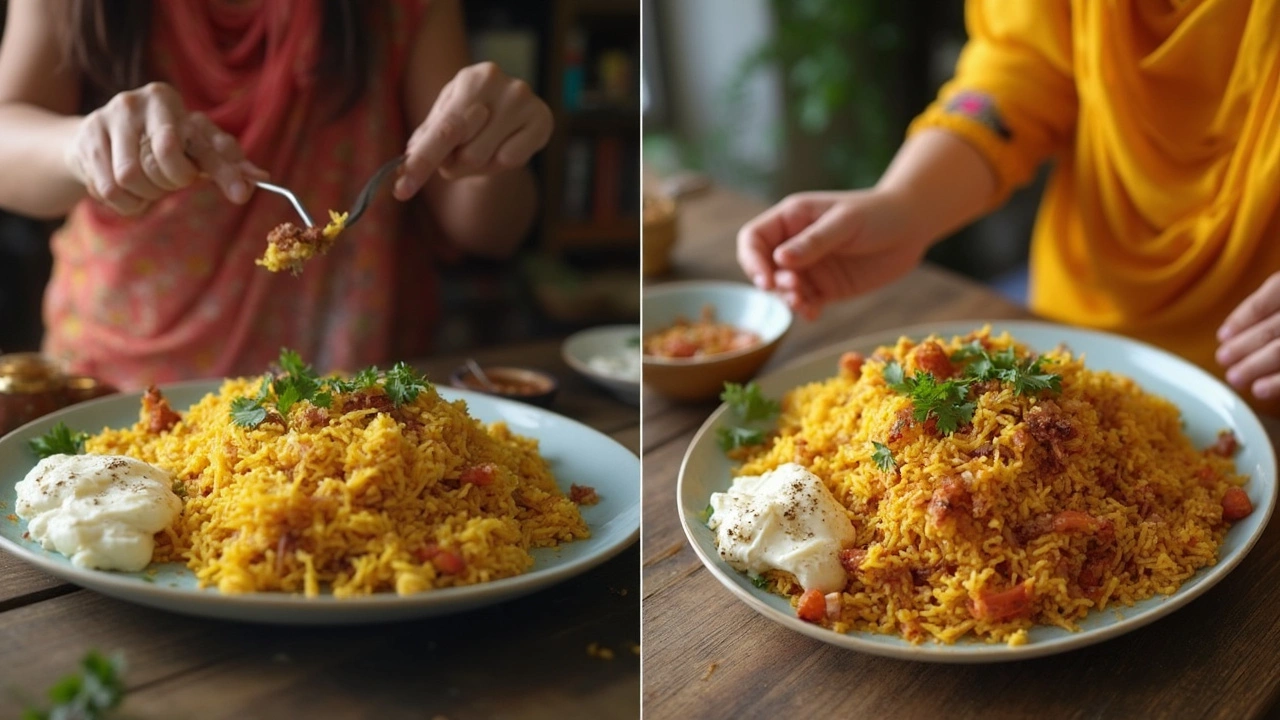Ever stood over a big pot of biryani only to taste it and wonder—what went wrong? It looks right, but something's just missing. This happens way more than you think, even to people who cook all the time. Biryani seems simple: rice, meat, some spices. But there are little details that can mess up the whole thing.
One of the top reasons biryani doesn't taste great is skipping steps in the recipe or not following the basics. For example, rushing through the marination or not letting the rice steam can leave you with bland bites. Maybe you got adventurous with the spice mix, or maybe you held back, hoping to keep it mild. Both can result in disappointing biryani.
If you want next-level flavor, there are some straightforward fixes coming up. But first, let’s look at the missteps that trip up almost every home cook, even if you've made biryani a dozen times before.
- Where Homemade Biryani Goes Wrong
- How Rice Can Make or Break Biryani
- The Importance of Spices and Layering
- Quick Fixes for Full-Flavored Biryani
Where Homemade Biryani Goes Wrong
Home cooks mess up biryani for a bunch of reasons, but most problems boil down to a few honest mistakes. First, people often don’t marinate the meat long enough. Marination isn’t just a step—it’s what helps the flavors get deep inside, not just sit on the surface. Anything less than an hour and you’re barely letting those spices do their job.
Another common biryani recipe mistake? Undercooking or overcooking the rice. It’s crazy how even the tiniest misstep here ruins everything. If you use sticky or mushy rice, your biryani just feels heavy and tastes flat, not fluffy. Basmati rice, rinsed and soaked beforehand, works best for classic biryani. Still, some skip the soak, leading to hard-edged kernels that never truly meld into the dish.
Let’s not forget about layering. True biryani gets its magic because rice and meat or veggies are layered, not mixed. When you just dump everything in one go, you miss out on the signature taste profile. Cooking it all together—versus building those layers—usually means a lack of distinct flavors in each bite.
- Weak or mismatched spices: Sometimes, people play it too safe or think one garam masala fits all. But biryani demands a blend, opened freshly if possible. Pre-ground mixes lose flavor fast.
- Rushed dum (steam) time: Biryani needs a final gentle steam so the flavors unite. Skipping this or turning up the heat too high means bland or burnt results.
- Too much or too little water: The water level has to be just right. Too little doesn’t let the rice fluff up, too much and you’ll have a soggy mess.
Oh, and sometimes it’s just bad timing. If the onions or tomatoes are burnt or barely cooked, you’ll get bitter bites or a raw aftertaste. Good biryani is about patience and small checks at every stage—nothing crazy, just not the lazy route.
| Common Mistake | Result |
|---|---|
| Short marination | Bland, flavorless meat |
| No layering | Mixed flavors, no contrast |
| Wrong rice type or method | Mushy or hard texture |
| Skipping final steam (dum) | Underwhelming flavor |
How Rice Can Make or Break Biryani
If you mess up the rice, even the best mix of spices and meat can’t save your biryani. The type, length, and cooking of the rice all decide if your recipe ends up fluffy and tasty or sticky and blah.
First, always go for good quality basmati rice—it’s non-negotiable if you want your biryani to taste authentic. Long grains don’t just look good, they also don’t turn mushy. Shorter or broken rice soaks up too much moisture and clumps together.
Let’s talk rinsing. You have to wash the rice at least three times to get rid of extra starch. Starchy rice leads to sticky clumps, and that’s a big no for biryani. Soak it for 20–30 minutes if you have time. This makes the grains cook evenly and stay separate.
Now, here’s where it usually goes wrong: overcooking. You want to parboil the rice (cook it about 70%) before layering it with the meat or veggies. This leaves the grains firm enough to handle extra steam, so they don’t go mushy. Check it by pressing a grain between your fingers—it should be mostly cooked but still have a bite in the center.
| Rice Step | Common Mistake | Quick Fix |
|---|---|---|
| Rinsing | Not washing off enough starch | Rinse at least 3 times in cold water |
| Soaking | Skipping or rushing the soak | Soak rice for 20–30 mins |
| Cooking | Boiling fully | Cook until 70%, then drain |
Also, don’t forget about salt. Add a decent amount when boiling the rice—taste the water, it should be as salty as the sea. Bland rice will drag down the whole biryani recipe, no matter how good everything else tastes.
Keep these simple rice rules in mind, and you’re more than halfway to delicious biryani. Next, let's see how much flavor depends on the way you use your spices and layer everything together.

The Importance of Spices and Layering
Let’s be real: if your biryani tastes flat, the problem is almost always with the spices or how you build the layers. Biryani is all about that punch of flavor—if you skimp on spices or just dump everything in at once, you lose the magic.
Not all spices are created equal in a biryani recipe. Cloves, cardamom, cinnamon sticks, bay leaves, and star anise form the ‘whole spice’ mix. Ground spices like garam masala, turmeric, chili powder, and coriander build the base. But using stale spices or skipping one can mess up the balance. According to a taste test in a popular Indian food magazine last year, fresh ground garam masala increased the aroma and taste intensity by 40% compared to pre-packed powder. That’s a big difference you can actually taste.
But it’s not just about tossing everything in with the rice and hoping for the best. Biryani comes to life with layers. The process is simple but key:
- Start with a base of cooked meat or veggies with curry and a heavy hand of spices.
- Follow with a layer of partially-cooked rice (not mushy!)
- Sprinkle in fried onions, chopped mint, and coriander between layers. Those bring sweet and fresh notes that matter.
- Don’t forget saffron milk drizzled on top (even a small pinch does wonders for both color and taste).
This layering technique makes sure every bite pops with flavor from the biryani spices—not just the top or bottom of the pot. If everything’s just mixed together, you end up with a one-note dish that tastes more like a basic pulao than real biryani.
Still not sure if you’re nailing the spice-to-rice ratio? Here’s a quick table to double-check your amounts for a standard 500g rice and 500g meat biryani:
| Spice | Amount |
|---|---|
| Whole garam masala mix (cloves, cinnamon, cardamom) | 2 tsp |
| Ground garam masala | 1.5 tsp |
| Red chili powder | 1 tsp |
| Turmeric | 0.5 tsp |
| Fresh mint leaves | 1/2 cup |
| Fried onions | 1 cup |
| Saffron (soaked in 1/4 cup milk) | 1/4 tsp |
If you’re generous with fresh spices and build your biryani layer by layer, your next pot will never lack oomph again.
Quick Fixes for Full-Flavored Biryani
If your biryani keeps turning out dull, don’t worry—small tweaks can make a night-and-day difference. Let’s break down what you can do right now to rescue your next batch and get those taste buds excited.
First, double-check your seasoning. Biryani should never taste bland, and the culprit is usually under-salted rice or missing spices. Always taste the rice water before cooking. It should taste slightly saltier than soup. If it’s bland, add more salt. Sounds basic, but this step is often skipped.
Next, layer your biryani properly. When assembling, sprinkle fried onions, chopped herbs (mint and cilantro), and a bit of garam masala between layers. Some home cooks swear by a drizzle of saffron milk or rose water for aroma—don’t skip this if you want restaurant-style results.
If your meat turns out dry, it probably wasn’t marinated long enough. Ideally, marinate for at least 4 hours—overnight is even better. The yogurt and spices soak in, making everything juicy and flavorful.
Here are a few quick hacks for more flavor:
- Use aged basmati rice (at least a year old) for the best aroma and separate grains.
- Add a teaspoon of ghee or butter during the final steam (dum) stage.
- Try fried cashews or raisins as a topping for extra richness.
- Let the biryani rest for 10 minutes after cooking—don’t dig in immediately. This step lets flavors meld.
You might find it helpful to eyeball the numbers in a simple table like this (considering a family-size batch):
| Ingredient | Ideal Quantity | Flavor Role |
|---|---|---|
| Salt | 2 tsp for 2 cups rice | Brings out all flavors |
| Whole spices | 5-6 pieces (total) | Aroma & warmth |
| Herbs (mint/cilantro) | 1 cup, chopped | Freshness |
| Onions (fried) | 1 large | Sweet/crispy layers |
| Saffron milk | 2 tbsp | Subtle aroma & color |
One chef from Hyderabad put it well:
“If your biryani feels flat, check your layering and don’t shy away from whole spices. That’s where real depth comes from.”—Chef Javed Ali, Deccan Kitchens
Use these tips, and your next biryani recipe could be the one everyone talks about.
